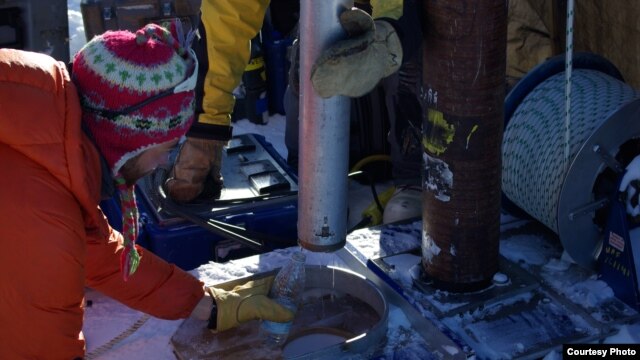Preglacial landscape found deep under Greenland ice
by Staff Writers
Washington (AFP) April 18, 2014
 |
US
geologists said Thursday they have uncovered a preglacial tundra
landscape preserved for 2.7 million years far below the Greenland ice
sheet.
Glaciers are known to scrape everything off any given plot of land -- vegetation, soil and even the top layer of bedrock -- so scientists expressed great surprise that they had found the landscape in pristine condition below two miles (three kilometers) of ice.
The finding provides strong evidence that the ice sheet has existed for much longer than previously known, and survived numerous global warming episodes, according to the lead researcher, University of Vermont geologist Paul Bierman.
Rather than scraping and sculpting the landscape, the ice sheet has been frozen to the ground, effectively creating "a refrigerator that's preserved this antique landscape," Bierman said.
The finding suggests that even during the warmest periods of the ice sheet's life, the center of Greenland was stable and did not fully melt, allowing the tundra landscape to be sealed without modification through millions of years of changing temperatures.
Read More Here
.....
.....
Glaciers are known to scrape everything off any given plot of land -- vegetation, soil and even the top layer of bedrock -- so scientists expressed great surprise that they had found the landscape in pristine condition below two miles (three kilometers) of ice.
The finding provides strong evidence that the ice sheet has existed for much longer than previously known, and survived numerous global warming episodes, according to the lead researcher, University of Vermont geologist Paul Bierman.
Rather than scraping and sculpting the landscape, the ice sheet has been frozen to the ground, effectively creating "a refrigerator that's preserved this antique landscape," Bierman said.
The finding suggests that even during the warmest periods of the ice sheet's life, the center of Greenland was stable and did not fully melt, allowing the tundra landscape to be sealed without modification through millions of years of changing temperatures.
Read More Here
.....
Massive canyon discovered buried under Greenland ice
A vast gorge in the Earth on the same scale as the Grand Canyon lies buried under ice in Greenland, scientists have learned.
The massive hidden canyon is at least 466 miles (740km) long and up to 800 metres (2,600ft) deep in places.
The feature, resembling a meandering river channel, is believed to pre-date the ice sheet that has covered Greenland for millions of years.

The massive hidden canyon is at least 466 miles (740km) long and up to 800 metres (2,600ft) deep in places.
The feature, resembling a meandering river channel, is believed to pre-date the ice sheet that has covered Greenland for millions of years.

3D visualisation of the canyon under Greenland's ice sheet. Photograph: Professor Jonathan Bamber
Prof
Jonathan Bamber, from the school of geographical studies at the
University of Bristol, said: "With Google Streetview available for many
cities around the world and digital maps for everything from population
density to happiness, one might assume that the landscape of the Earth
has been fully explored and mapped.
"Our research shows there's still a lot left to discover."
The canyon was uncovered by airborne radar which can penetrate ice and bounce off the land beneath.
Scientists pieced together radar measurements covering thousands of kilometres collected by Arctic researchers over several decades. They found evidence of a fissure in the bedrock stretching northwards almost from the centre of Greenland.
The canyon ends in a deep fjord connecting it to the Arctic ocean.
Read More Here
"Our research shows there's still a lot left to discover."
The canyon was uncovered by airborne radar which can penetrate ice and bounce off the land beneath.
Scientists pieced together radar measurements covering thousands of kilometres collected by Arctic researchers over several decades. They found evidence of a fissure in the bedrock stretching northwards almost from the centre of Greenland.
The canyon ends in a deep fjord connecting it to the Arctic ocean.
Read More Here
.....





